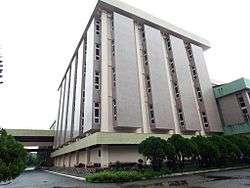National Museum of Myanmar
| အမျိုးသား ပြတိုက် | |
 | |
| Established | 1952 |
|---|---|
| Location |
66/74 Pyay Road Dagon 11191, Yangon Yangon Division, Myanmar |
| Owner | Ministry of Religious Affairs and Culture (Myanmar) |
| Website | http://asemus.museum/museum/national-museum-yangon |
The National Museum (Yangon), (Burmese: အမျိုးသား ပြတိုက်), located in Dagon, Yangon, is the one of the national museum of Burmese art, history and culture in Myanmar. Founded in 1952, the five-story museum has an extensive collection of ancient artifacts, ornaments, works of art, inscriptions and historic memorabilia, related to history, culture and civilization of Burmese people.[1]
History
The National Museum of the Union of Burma was first opened in June, 1952 at the Jubilee Hall Building on Shwedagon Pagoda Road, Yangon. The museum was moved to a larger location at 24/26 Pansodan Street in 1970, and to its present location in 1996. The new five story National Museum has been open to public since 18 September 1996.[2]
Galleries
The museum's collections are displayed over the following 14 galleries or halls.[2]
| Burmese Culture | Burmese Historic Periods |
|---|---|
|
|
Burmese culture
- The Burmese Epigraphy and Calligraphy hall on the Ground Floor contains exhibits on the origins and development of Burmese script/alphabet throughout history, as well as exhibits on other ancient and ethnic scripts.
- In the hall on culture are exhibits on Burmese rural life, covering social, economic and cultural traditions and modes of transport. Examples include a traditional Burmese bullock cart, still in use in many parts of the country, an offering bowl for monks, gilded and wrought with mosaics of semi-precious stones, and personal ornaments and jewelry worn by the Burmese people since ancient times.
- The Halls of Arts covers the progress of Burmese art, beginning with the cave paintings of the stone age to the Bagan, Innwa, Taungoo, Konbaung and Yadanabon periods to 20th century contemporary art. The works of famous artists are on display.
- In the Hall of Performing Arts are many musical instruments and an ornate saingwaing (traditional Burmese orchestra) as well as marionettes used in classical dramas and operas.
- The Hall of Ethnic Culture on Fourth floor shows national dresses and traditional artifacts of various ethnic groups of Myanmar.
- Fourth floor of the museum consists of halls for the Buddha Images, dating back to the Pyu Period and up to the present day.
Historic periods
- In the exhibit hall on Natural History are many fossils dating back millions of years, including a 40-million-year-old an anthropoid primate, found in the Pondaung region in Upper Myanmar.
- The hall of Pre-historic Times houses a replica of the Padalin Cave, complete with its over 10,000-year-old stone age drawings, stone weapons of the neolithic period, and bronze weapons of a later age. The hall also has exhibits on Pyu period (1st-to-9th century) artifacts such as clay pots, urns, votive tablets and necklaces as well as those found in archaeological excavations at the ancient Pyu city of Sriksetra.
- In the hall of Burmese History are exhibits on the pagodas, temples, monasteries and ordination halls of the Bagan Period and the marvelous murals of the Pinya, Innwa, Taungoo, and Konbaung periods. Rare ancient votive tablets with moldings from scenes of the jataka stories are also on display.
- The Royal Regalia hall houses displays of beautifully ornamented objects used in royal ceremonies of ancient kings from different periods.
- The Throne Room houses miniature models of the eight kinds of thrones of ancient Burmese kings and the magnificent Royal Lion Throne of the last Burmese monarch King Thibaw in all its original majesty, used in Hluttaw Hall (or Hall of Council of Ministers).
- The Yadanabon Period Exhibit hall has displays on clothing fashions, furniture and other household articles of the time such as a palanquin used by King Thibaw's Chief Abbot.
See also
References
- ↑ "National Museum". Archived from Myanmar travel information the original Check
|url=value (help) on 2008-05-12. Retrieved 2008-10-25. - 1 2 "National Museum". Retrieved 2008-10-25.
Literature
- Lenzi, Iola (2004). Museums of Southeast Asia. Singapore: Archipelago Press. pp. 200 pages. ISBN 981-4068-96-9.